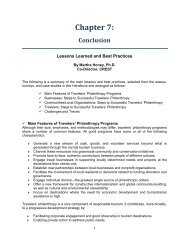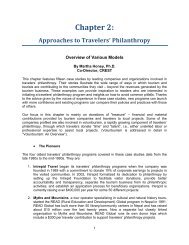Travelers' Philanthropy Handbook - Center for Responsible Travel
Travelers' Philanthropy Handbook - Center for Responsible Travel
Travelers' Philanthropy Handbook - Center for Responsible Travel
Create successful ePaper yourself
Turn your PDF publications into a flip-book with our unique Google optimized e-Paper software.
donors, and monitor projects. IGTOA charges a membership fee which provides funds <strong>for</strong> itsbasic operating expenses. Loreto Bay’s master plan stipulated that 1% from the gross sale andresale of vacation homes go to the community foundation, thereby ensuring a continuing streamof income. Similarly, the NYRP’s New Leaf Restaurant is providing a steady income to supportits urban garden projects. Both Myths and Mountains and Selva Verde Lodge/Holbrook <strong>Travel</strong>began by building library/community centers which have then grown to encompass a range ofother community projects and income generating activities that help finance the library complex.• VoluntourismWhile all these companies are providing “treasure” – money and material goods – to theprojects they support, they hold mixed views of voluntourism. Four of the companies thatprovided case studies do not offer guests volunteer opportunities. They cited a number ofreasons: work on local projects can and should be done by residents so that they feel ownership(Myths and Mountains), volunteers can take jobs from locals (Intrepid and Global Sojourns), andfinancial investments do more good than volunteering (GoPhilanthropic).Most of the companies that place volunteers in their projects do so in a well-organized manner.Calabash Tours has worked with a UK partner organization to create a self-fundingvoluntourism program that only accepts volunteers with specific skills and requires them to stay<strong>for</strong> a minimum of one month. Calabash finds that volunteers benefit the project by transferringskills to local participants and taking their inspiration and understanding back to their homecommunities thereby building wider networks of contributors.• Key LessonsThe case studies highlight a number of challenges that companies face in setting up effectivetravelers’ philanthropy programs. These include:• How to identify projects that are priorities <strong>for</strong> the host community instead of those thatseem important to the company or visitors;• How to select and manage voluntourism projects that are appropriate and beneficial <strong>for</strong>the host community; and• How to offer appropriate site visits recognizing they are important to visitors and mayhelp secure additional funding but can be disruptive <strong>for</strong> the local organizations.These case studies also contain a number of keys to success and best practices that arecomponents of successful travelers’ philanthropy programs. Some of these take aways are:• Identify or create a local foundation or other structure separate from the tourismbusiness to receive contributions and run travelers’ philanthropy projects;• Ensure transparency in how contributions are used, including regular auditing andreporting to donors;• Support needs-focused rather than donor-driven projects;• Build in mechanisms <strong>for</strong> sustainability through local income-generating activities (orsources of revenue other than the travelers, including foundations);• Make travelers’ philanthropy an integral part of company’s business plan and corporatesocial responsibility strategy, and not simply an add-on activity; and• Engage in continual and honest assessment and evaluation, recognize and learn frommistakes, and strive <strong>for</strong> improvement.31















